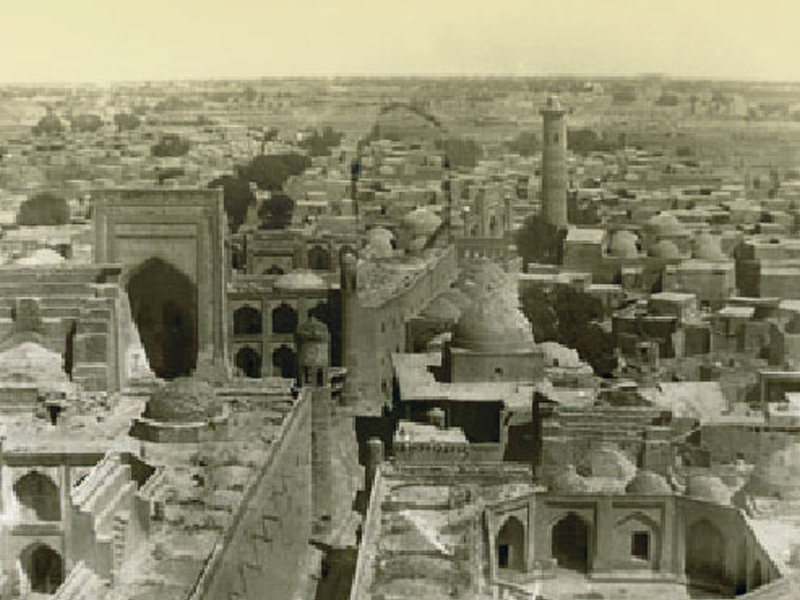



Attraction

Recreation

Khiva was mentioned in the texts as early as in the 10th century. And only in the 15th century the role of this city becomes more prominent due to the ruin and decay of Gurgandj (Urgench) caused by the changed course of Amudarya River. Under the rule of Asfandiyar (1623-1643) and Abul-gazi (1643-1663) khans Khiva becomes the capital of Khorezm.
A beautiful legend about the emergence of Khiva tells that Shem, the son of Noah, was sleeping on a sand dune and saw a sign in his dream; following it, he put together some earth and created a city that looked like a ship, and he dug a Heivak well for it. If one looks at the city with the bird’s eye, one is bound to believe that Khiva was indeed built on sand, which was eventually confirmed by archaeological research.
One never ceases to admire the art of the nation’s genius who created these wonderful architectural monuments, which are distinct from those of Samarqand and Bukhara in the originality of shapes and their unusual spatial composition, where everything is “integrated by a single artistic style – the signature of Khorezmian masters of the 18th-19th centuries”.
Structural features of Central Asian cities are characteristic of the Khiva architecture: Ichan-kala – shakhristan, Dishan-kala – medieval rabad, and Kunya-Ark – “kukhenzida”. One of the earliest monuments in Ichan-kala dating to the first three decades of the 14th century is believed to be the Seyeed Alauddin mausoleum. Originally it was a single-dome burial-vault, or gurkhana, (3.7 x 3.7 m) with a portal entrance in its southern wall. Following an established custom, “depending on the Saint’s rank and popularity, his mausoleum could grow and become a multi-chamber building” (2, p. 34). Only in the 18th century a western annex, ziarat-khana, was built (6.0 x 6.0 m). Both chambers are covered with domes: the one over the gurkhana is shaped as a triangle flat sail, and the dome over the ziarat-khana rests on arch sails with perspective-cellular small niches at the corners.
Contrast is specific of Khiva. In this case, a modest interior is contrasted with colourful tombstone, “so eminent that …it appears to be brought from another place”. It is a monumental piece: tiered pedestal base supports a pedestal decorated with carved, festive columns at the corners. On the pedestal there are two mini-sagans. The tombstone is completely covered with majolica – a classical specimen of Khorezmian style of the first half of the 14th century. The motifs are flower and vegetable, originating from ancient Khorezmian and Sogdian specimens. Colours such as deep-blue, light-blue and pistachio give freshness to the design.
Another monument of cult architecture dating to the 14th – 20th centuries is a complex near the mausoleum of Pahlavan Mahmud (1247-1325), poet and wrestler. He was considered patron of a manmade canal taking water from Amudarya River. The cult of this Saint existed during the last 150 years of the Khiva khans rule (late 18th – 20th centuries) and is mentioned in many legends. Shir Muhammed Munis in his “Firdaus al-Ikbale” noted: “The blessed burial vault of the world’s pinnacle and the greatest leader Pahlavan Mahmud, the son of Pir-i Mirvali”. The legend tells that in the 14th century in place of the complex there was Pahlavan Mahmud’s workshop; it was typical of medieval cities to have one’s workplace in the same building as one’s home (3, p. 79). According to the tradition, over time, a single-chamber mausoleum (gumbaz or buzruk) grew into a large compound to become one of the finest memorial and cult complexes of Kungrat dynasty. The layout of the complex follows the following scheme: at the centre there is a khonakoh with three embrasures: the western embrasure leads to ziaratkhana connected to gurkhana with the Saint’s tombstone in it. The Eastern embrasure is connected to a corridor that, in turn, connects to a square building. In the southern side of the complex there are korikhona, oshkhona, a mosque and darvazakhona.
One of the typical features of the Khiva architecture is the interconnection between old and new parts of the buildings, thus uniting structures created in different times while ensuring “that the components of the architectural ensemble retain their originality”. In this case this is achieved with painted majolica: “These glistening tiles excite admiration that opens the way to the world of spirituality” (4, p. 40). Particularly exquisite is the interior of a mausoleum where the architects cleverly distributed the tiling: at the bottom there is a geometric panel (white design against deep-blue background; tier under the dome features large yellow and blue shapes; and inside the dome they used one of the most favoured devices in interior decoration – white medallions against deep-blue background.
Another specific feature of the Khiva school of architecture is its masters’ great skill in wood-carving cleverly combined with architectural forms and proportions, which is used in “the details and structures most advantageous for observation” (5, p. 193). Carved designs covered the outdoor elements, such as doors, gates, aivan columns… Some of them were the only decoration in a monument. For instance, the most remarkable feature of Juma mosque is its columns. Situated at the centre of Ichan-kala, the mosque is trapezoid in plane and has beam ceiling supported by 212 columns. An established fact is the tradition of transferring unique specimens of the 10th – 14th cc. wooden columns into later date structures. For instance, in Juma mosque one can find columns dating from the 10th to 16th century – each of them bearing decoration specific of its time – united into one compositional array. All of them are graceful and form an airy ambiance because the masters “keenly calculated the scale of the pattern and the rise of the relief”.
The Tash-Khauli (stone-yard) palace is a cherry in the pie of Ichan-kala – its graceful outline keeps delighting one’s eye. The palace consists of three parts: harem, ishrat-khauli (the court of entertainment) and arz-khana (trial court) – built in the same sequence between 1830 and 1838. It’s quite interesting that in the palace layout the architects were guided by the traditions of both old Khorezmian mansions (for example, the women’s half of the harem), and fortress architecture manifested in blind facades. The main theme is the courtyard surrounded by different chambers. All the charm of the Tash-Khauli is concentrated inside. The harem consists of five sections, each of them with a splendid aivan [veranda], a residential chamber and a storage room. Both ishrat-khauli and arz-khana have similar type of layout: around stretched courtyards there are two-light single-column aivans serving as spatial connecting element. Behind them are reception halls and corridors. In the ishrat-khauli there are guest rooms along the courtyard perimeter; service rooms with aivans are on the second floor. Arz-khauli has more complex layout.
The peculiarity of the Tash-Khauli is in the broken rules of symmetry; yet this does not interfere with the overall look but highlights it. It is manifested in arz-khauli where the aivan is displaced relative to the courtyard axis. In ishrat-khauli the aivan semi-towers are also asymmetrical: two of them in the west, and one in the east. Columns of the courtyard aivans are also “installed under the purlins where it is structurally required”. That is, the use of asymmetry as compositional device played a balancing role in creating an integral architectural composition.
Expressive and dynamic appearance of the Tash-Khauli palace has been achieved also due to the employment of another compositional resource – contrast. For instance, unlined palace exterior is contrasted with internal fa?ades performed in the spirit of “saturated designs and colourful wall development” (6, p. 168); in the palace facades mosaic walls are contrasted with elegant aivans; darkened passages (leading from the harem to ishrat-khauli) – with sunlit courtyards; minor aivan columns – with two-light ones; modest interior decoration – with resplendent facades. The latter were faced with deep-blue-white-light-blue majolica resembling syuzane cover. Thus, the range of contrasted juxtapositions in this monument is endless and helps to expose important spatial areas, volumes and details. One cannot help but recall the words of Francois Blondel Junior, theorist of French architecture: “Satisfaction we experience when looking at a beautiful piece of art depends on how correctly proportions are maintained” .
The original architecture of Khiva is remarkable in its refined taste – natural blend of applied art with architectural shapes and proportions, which gives the monuments complete and wholesome look. The origins of Khiva architecture have their roots in traditional building guided by natural and climatic conditions and centuries-old traditions; besides, it is based on contrasted combinations manifest both in details and spatial compositions, and on close relationship between inner space and its shape and environment.
Centuries go by, but the walls of the monuments still breathe the energy built into them by medieval architects. For the next generation it brings the art of creating new architectural masterpieces.
Literature
1. Захидов П.Ш. О школах зодчества Узбекистана (XIX-XX вв.) // ИЗУ, IV. Ташкент, 1969.
2. Снесарев Г.П. Хорезмские легенды как источник по истории религиозных культов Средней Азии. М., 1983.
3. Маньковская Л., Булатова В. Памятники зодчества Хорезма. Ташкент, 1978.
4. Пугаченкова Г. А. Термез, Шахрисабз, Хива. М., 1976.
5. Аведова Н.А. Живые традиции хивинской резьбы по дереву // ИЗУ, IV. Ташкент, 1969.
6. Пугаченкова Г.А., Ремпель Л.И. Выдающиеся памятники архитектуры Узбекистана. Ташкент, 1958.
7. Ноткин Н. Искусство древних. Ташкент, 1968.
Shoira Nurmukhamedova